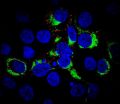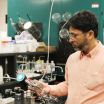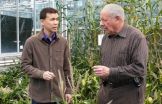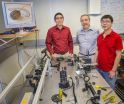(Press-News.org) MANHATTAN, Kan. — A collaborative study involving Kansas State University researchers has discovered a new gene expression mechanism in porcine reproductive and respiratory syndrome, or PRRS, virus — an important swine pathogen that costs the U.S. pork industry more than $600 million a year. The discovery provides a new avenue for scientists to explore strategies to control and prevent the disease.
Ying Fang, Ph.D., associate professor of diagnostic medicine and pathobiology at Kansas State University, led a study that looked at the unique gene expression mechanism of the PRRS virus. She and colleagues found a new protein in the virus, nsp2TF, was generated through novel ribosomal frameshifting signals.
The research recently appeared in the Proceedings of the National Academy of Sciences, or PNAS, study, "Transactivation of programmed ribosomal frameshifting by a viral protein."
Fang conducted this study with her European collaborators, including Eric Snijder and his team members at Leiden University Medical Center in The Netherlands, and Andrew Firth, Ian Brierley and Brierley's lab members at the University of Cambridge. Yanhua Li, Fang's doctoral student in pathobiology, China, made important contributions to this study. Zhi Sun, Fang's former doctoral student, and Longchao Zhu, visiting scholars in diagnostic medicine and pathobiology in Fang's lab, also were involved in the study.
The study builds on a 2012 PNAS study Fang and her European collaborators conducted while she was at South Dakota State University. In it, researchers identified the nsp2TF protein in the PRRS virus. The protein is expressed through a new gene expression mechanism called -2 ribosomal frameshifting.
"Frameshifting occurs when a ribosome encounters a 'slippery' sequence and downstream signal in messenger RNA," Fang said. "This causes the ribosome to shift two nucleotides backward, which results in all the genetic codons downstream of the shifted site to be read differently and produce a new protein that has a different function."
With the most recent study, Fang and colleagues have shown that this -2 frameshifting requires a PRRS virus protein, nsp1beta. It is the first time a virus's genetic mechanism has been found to require the action of a transacting viral protein rather than a RNA structure to induce a ribosomal frameshifting, which is novel in the protein translation field.
The function of the nsp2TF protein is currently under investigation, Fang said. The protein contains a genetic element that may be responsible for suppressing the pig's immune system.
The newly identified ribosomal frameshifting mechanism may provide an additional antiviral target. Fang's research lab cloned the PRRS virus and then genetically engineered nsp2TF protein knockout viruses.
"These knockout viruses could be potentially used to develop vaccines," Fang said. "Additionally, this novel mechanism of gene expression may also be used by other viruses or in cellular gene expression."
Fang joined Kansas State University in 2013.
"Dr. Fang is recognized as one of the top PRRS experts in the world," said M.M. Chengappa, university distinguished professor of microbiology and head of the department of diagnostic medicine and pathobiology. "We are so fortunate to have faculty of her caliber and stature at Kansas State University. She brings enormous depth and breadth to our research and graduate training program."
INFORMATION:
Researchers find a new gene expression mechanism of PRRS virus
New virus prevention strategies now possible
2014-05-12
ELSE PRESS RELEASES FROM THIS DATE:
Hospitals ranked on complications after hip and knee replacement surgeries
2014-05-12
With an aging population comes an increase in hip and knee joint replacement surgeries, totaling almost one million procedures per year in the United States. To provide better information on the outcomes of these surgeries, help inform patient choice, and improve the quality of the nation's hospitals, a team of Yale School of Medicine researchers have developed a measure for hospitals based on the complications following their patients' hip and knee replacements.
The team published an article in the May issue of the Journal of Bone and Joint Surgery showing there are ...
Dartmouth scientists identify genetic blueprint for cancerous tumors of the appendix
2014-05-12
Using next generation DNA sequencing, Dartmouth scientists have identified potentially actionable mutations in cancers of the appendix. Their study, "Molecular Profiling of Appendiceal Epithelial Tumors Using Massively Parallel Sequencing to Identify Somatic Mutations," was published in the journal Clinical Chemistry today. When specific mutations for a cancer type are identified, patients can be treated with chemotherapy or other targeted agents that work on those mutations.
Little is known about the molecular biology of two types of appendix tumors, low-grade appendiceal ...
Ames Lab creates multifunctional nanoparticles for cheaper, cleaner biofuel
2014-05-12
The U.S. Department of Energy's Ames Laboratory has created a faster, cleaner biofuel refining technology that not only combines processes, it uses widely available materials to reduce costs.
Ames Laboratory scientists have developed a nanoparticle that is able to perform two processing functions at once for the production of green diesel, an alternative fuel created from the hydrogenation of oils from renewable feedstocks like algae.
The method is a departure from the established process of producing biodiesel, which is accomplished by reacting fats and oils with alcohols.
"Conventionally, ...
Mount Sinai researchers identify changes that may occur in neural circuits due to addiction
2014-05-12
A research team from the Friedman Brain Institute of the Icahn School of Medicine at Mount Sinai has published evidence that shows that subtle changes of inhibitory signaling in the reward pathway can change how animals respond to drugs such as cocaine. This is the first study to demonstrate the critical links between the levels of the trafficking protein, the potassium channels' effect on neuronal activity and a mouse's response to cocaine. Results from the study are published in the peer-reviewed journal Neuron on May 7, 2014.
The authors investigated the role of ...
Corn dwarfed by temperature dip suitable for growing in mines, caves
2014-05-12
WEST LAFAYETTE, Ind. - Lowering temperatures for two hours each day reduces the height of corn without affecting its seed yield, a Purdue study shows, a technique that could be used to grow crops in controlled-environment facilities in caves and former mines.
Raising the crops in isolated and enclosed environments would help prevent genetically modified pollen and seed from escaping into the ecosystem and crossing with wild plants.
Cary Mitchell, professor of horticulture, said the technique could be particularly useful for growing transgenic crops to produce high-value ...
INFORMS study: Online buzz forecasts new product performance months before product release
2014-05-12
Companies can significantly improve the forecasting accuracy of forthcoming products' performance by mining online consumer buzz prior to product release, according to a study being published by Marketing Science, a journal of the Institute for Operations Research and the Management Sciences (INFORMS).
Social media attention to a firm's forthcoming products also influences its stock price, the study shows.
Pre-Release Buzz Evolution Patterns and New Product Performance is by Guiyang Xiong and Sundar Bharadwaj, professors at Terry College of Business at the University ...
Potential cure for captive amphibians with chytrid fungus
2014-05-12
Researchers at Vanderbilt University have identified an alternative to a sometimes toxic therapy that protects frogs in zoos from a deadly fungal infection that has been destroying the amphibian populations worldwide. Their research is published ahead of print in Applied and Environmental Microbiology.
The fungal disease, chytridiomycosis, has been decimating frogs all over the world. At present, nothing can help amphibians in the wild, but zoos currently rely on the often-toxic itraconazole to eradicate the disease from infected amphibians they wish to acquire.
To ...
UBC scientists find new way to mobilize immune system against viruses
2014-05-12
University of British Columbia scientists have uncovered an intricate chain reaction in the body's immune system and have used the knowledge to develop a new treatment against harmful viruses.
Viral pandemics, such as the coronavirus that caused the deadly SARS outbreak in 2002, have caused hundreds of deaths in Canada, yet effective anti-viral drugs are rare.
A key element to this natural immune response is an antiviral protein in the blood called Interferon alpha. Like soldiers, Interferon alpha is quickly deployed by the body to fight viruses and removed just as ...
Alcohol and drugs: Not just for modern man
2014-05-12
Unlike modern Man, the prehistoric people of Europe did not use mind-altering substances simply for their hedonistic pleasure. The use of alcohol and plant drugs – such as opium poppies and hallucinogenic mushrooms – was highly regulated and went hand-in-hand with the belief system and sacred burial rituals of many preindustrial societies. Elisa Guerra-Doce of the Universidad de Valladolid in Spain contends that their use was an integral part of prehistoric beliefs, and that these substances were believed to aid in communication with the spiritual world. Guerra-Doce's research ...
All in the rotation
2014-05-12
Viruses are the enigma of the biological world – despite having their own DNA and being able to adapt to their environment and evolve, they are not considered to be alive like cells. In order to reproduce and multiply – a requirement of "life" - a virus must invade a living cell, eject its DNA into that of the cell, and commandeer the cell's biological machinery. While a virus, essentially, may be nothing more than a dollop of DNA packed into a protective coating of protein called a capsid, the packaging of that DNA is critical. The molecular motors that drive this DNA ...
LAST 30 PRESS RELEASES:
Numbers in our sights affect how we perceive space
SIMJ announces global collaborative book project in commemoration of its 75th anniversary
Air pollution exposure and birth weight
Obstructive sleep apnea risk and mental health conditions among older adults
How talking slows eye movements behind the wheel
The Ceramic Society of Japan’s Oxoate Ceramics Research Association launches new international book project
Heart-brain connection: international study reveals the role of the vagus nerve in keeping the heart young
Researchers identify Rb1 as a predictive biomarker for a new therapeutic strategy in some breast cancers
Survey reveals ethical gaps slowing AI adoption in pediatric surgery
Stimulant ADHD medications work differently than thought
AI overestimates how smart people are, according to HSE economists
HSE researchers create genome-wide map of quadruplexes
Scientists boost cell "powerhouses" to burn more calories
Automatic label checking: The missing step in making reliable medical AI
Low daily alcohol intake linked to 50% heightened mouth cancer risk in India
American Meteorological Society announces Rick Spinrad as 2026 President-Elect
Biomass-based carbon capture spotlighted in newly released global climate webinar recording
Illuminating invisible nano pollutants: advanced bioimaging tracks the full journey of emerging nanoscale contaminants in living systems
How does age affect recovery from spinal cord injury?
Novel AI tool offers prognosis for patients with head and neck cancer
Fathers’ microplastic exposure tied to their children’s metabolic problems
Research validates laboratory model for studying high-grade serous ovarian cancer
SIR 2026 delivers transformative breakthroughs in minimally invasive medicine to improve patient care
Stem Cell Reports most downloaded papers of 2025 highlight the breadth and impact of stem cell research
Oxford-led study estimates NHS spends around 3% of its primary and secondary care budget on the health impacts of heat and cold in England
A researcher’s long quest leads to a smart composite breakthrough
Urban wild bees act as “microbial sensors” of city health.
New study finds where you live affects recovery after a hip fracture
Forecasting the impact of fully automated vehicle adoption on US road traffic injuries
Alcohol-related hospitalizations from 2016 to 2022
[Press-News.org] Researchers find a new gene expression mechanism of PRRS virusNew virus prevention strategies now possible



